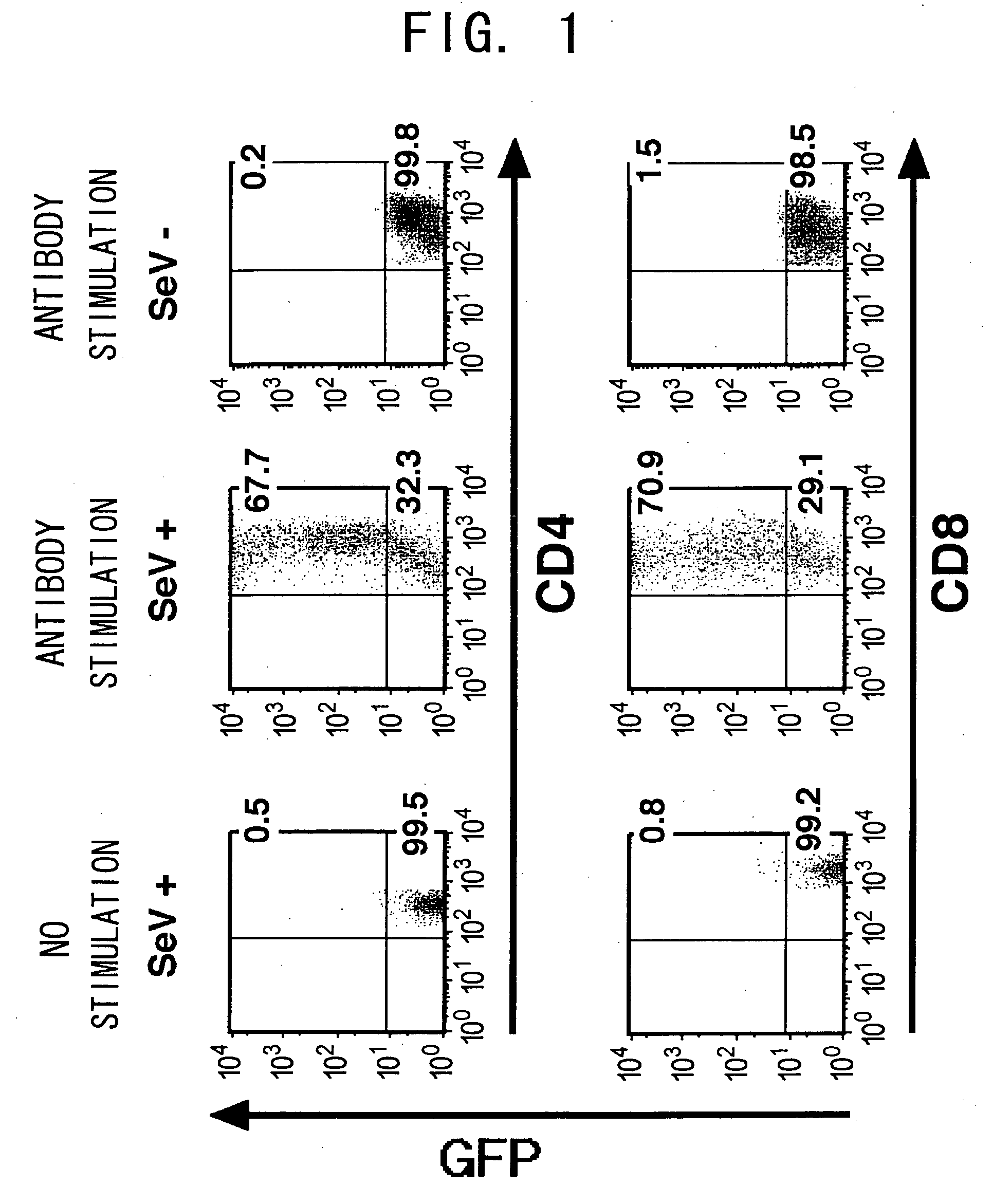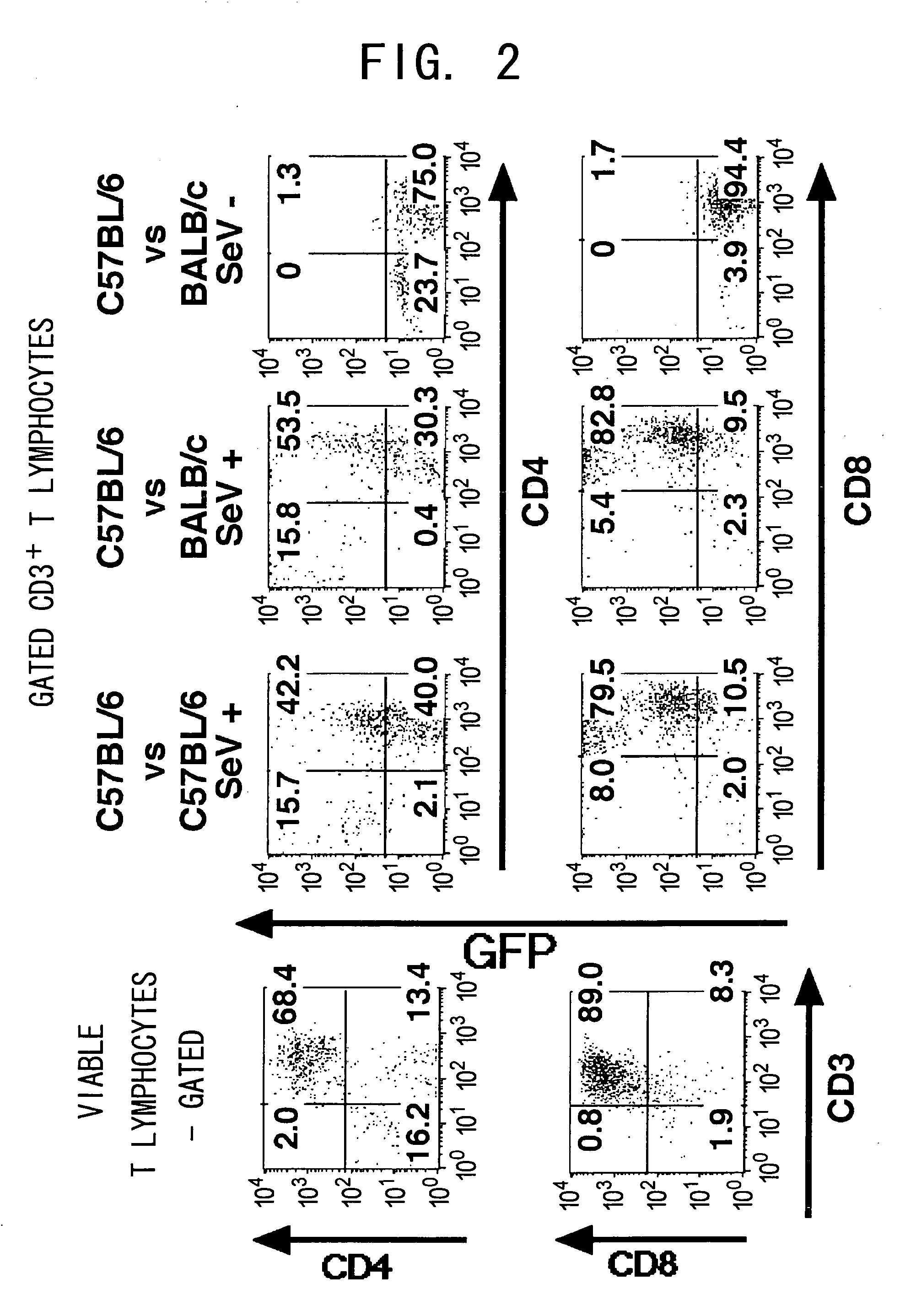Methods of Tranducing genes into T cells
- Summary
- Abstract
- Description
- Claims
- Application Information
AI Technical Summary
Benefits of technology
Problems solved by technology
Method used
Image
Examples
example 1
Recombinant SeV Transduces EGFP into Activated T Cells with a High Efficiency
[0110] Whether Sendai virus vectors can transduce EGFP gene into T cells was examined. First, murine lymphocytes were cultured with SeV-EGFP (MOI=62.5) for 48 h. While the ratio of EGFP-positive cells in unstimulated murine CD3+ CD4+ or CD3+ CD8+T cells (also referred to as CD4 T cells or CD8 T cells) was low (0.5 to 1.5% and 0.8 to 2.0%, respectively), CD3+ CD4+ or CD3+ CD8+T cells non-specifically activated with the immobilized anti-CD3 antibody and anti-CD28 antibody expressed EGFP at high levels, and the ratio of EGFP-positive T cells dramatically increased (65 to 85% and 70 to 92%, respectively) (FIG. 1). In both cases of CD4 and CD8 T cells, the ratio of EGFP-positive cells increased in a SeV dose-dependent manner and nearly reached a plateau level at an MOI of 12.5.
[0111] Next, to examine whether it is possible to transduce genes into antigen-acitvated T cell lines, an alloantigen was used as a T c...
example 2
Duration of Transgne Expression by SeV in Activated T Cells
[0114] Next, in vitro maintenance of the transduced gene was examined. Activated 2C T cells were cocultured with the Sendai virus, and the transduced T cells were maintained in vitro with either Balb / c stimulators or C57BL / 6 stimulators. EGFP expression level rapidly decreased following a peak expression at 48 h after the infection, but was maintained for at least 20 days (FIG. 5 and data not shown). EGFP expression level was not elevated, even with antigen re-stimulation using the Balb / c stimulators. These findings were observed also in the allospecific activated T cell lines (data not shown).
example 3
Gene Delivery into Activated Human T Cells and T Cell Lines
[0115] Freshly isolated human PBL from healthy donors were cultured with 2.5×107 PFU of SeV-EGFP expression vector (MOI=30) for 48 h. In contrast to murine T cells, although EGFP expression intensities were relatively low in unstimulated human CD3+ CD4+ and CD3+ CD8+ T cells, relatively high EGFP positive ratios were obtained (mean ratio=23.1% in the range of 15 to 45%, and mean ratio=34.0% in the range of 18 to 50%, respectively) (FIG. 6).
[0116] The present inventors hypothesized that the activated / memory T cell populations might be higher in human PBL than in mouse lymphoid tissues that had been maintained under specific-pathogen-free conditions. Naive T cells (CD45RA+ CD62L+) were separated from activated / memory T cells, and the EGFP expression of each T cell population was analzyed. As expected, the EGFP-positive activated / memory T cells had an exceptionally higher ratio of EGFP-positive cells than naive T cells which ...
PUM
 Login to View More
Login to View More Abstract
Description
Claims
Application Information
 Login to View More
Login to View More - R&D
- Intellectual Property
- Life Sciences
- Materials
- Tech Scout
- Unparalleled Data Quality
- Higher Quality Content
- 60% Fewer Hallucinations
Browse by: Latest US Patents, China's latest patents, Technical Efficacy Thesaurus, Application Domain, Technology Topic, Popular Technical Reports.
© 2025 PatSnap. All rights reserved.Legal|Privacy policy|Modern Slavery Act Transparency Statement|Sitemap|About US| Contact US: help@patsnap.com



